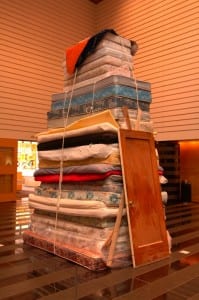Every artist selects their documentation differently, from pictures or videos to even using plastic dolls. For British artist Joshua Sofaer he decided to invite his participants on a scavenger hunt, where they would find and collect the objects in question. The collected objects are an example of how Sofaer could choose to document his work. After the scavenger hunt the objects were displaced in the San Francisco Museum of Modern Art, SFMOMA. Sofaer invited the ‘audience [to] become ‘artists’’ (Sofaer, 2009, 63) as they the ones who created the final piece.
The teams were given clues of the objects ‘they had to find, scavenge, borrow or blag,’ (Sofaer,2009, 63). The hunt would take them all around the city. Once all the teams had found as many objects as they could scavenge, they then had to return to the museum to see what team had collected the most. The winning team would win $4,000, by having a cash prize this would easily attract a large audience. Sofaer then took all the found objects and then collectively displayed them. Some of the collected items included were; mattresses, fried eggs, shoe box and superman figurer.
By Sofaer displaying the found scavenger hunt items it allowed the participants to come back to the museum and the results of the hunt. All the participants used the city as a space in which to create their piece by scavenging for the predetermined items. ‘The touching of the space ignites a haptic relationship between the space and the inhabitants.’ (Govan et al,2007,111). Additionally by attaining the objects from different areas in the city and then by displaying them together, it could represent the coming together of the space, the city, and the participants. By ‘carry[ing] the trace of their route to the gallery long after the performance of scavenging the city has ended.’ (Sofaer, 2009, 65). By using the scavenger hunt items as a form of documentation it demonstrates how everyday objects can tell the story of the performance. Also it’s a unique way of documenting the hunt as even if the audience did not participate they can see the result of it and experience the piece.
Work Cited;
Govan, E., Nicholson, H. and Normington, K. (2007) Making a Performance, Devising Histories and Contemporary Practices. London: Routledge.
Sofaer, J. (2009) The Many Headed Monster. London: Live Art Development Agency.
SFMOMA (2006) SFMOMA Scavengers. [online] Available from http://www.sfmoma.org/exhib_events/exhibitions/270 [Accessed 9 April 2015].
Image from; http://www.joshuasofaer.com/2011/06/scavengers/

Recent Comments